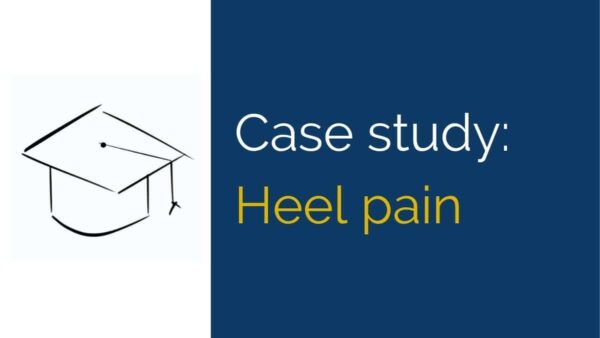Background – Heel pain
This heel pain case study looks at establishing a firm diagnosis, formulating a management plan including effective modifications to training and utilising adjunct/non-Physio treatment options.
Minimum level
Physiotherapist with 1+ year experience
History
Jeremy is an 15 year old who complains of worsening Left heel pain over the last 6-8 weeks.
The pain began after a mid-season game of football (soccer) but he can’t recall any incident during the game.
How does the mid-season timing of the onset of injury, compared to an early or pre-season onset, affect your reasoning?
Initially the heel pain last for a few hours after a game however it now remains sore for over 24 hours after games or training.
The pain feels like it’s on the back of his heel and gets uncomfortable with pressure from footwear such as his football boots or school shoes.
What is the likelihood that tight shoes are the cause of this injury?
Jeremy has not suffered any injuries in the past 12 months but was diagnosed with Osgood-Schlatter Disease two years ago. That episode lasts six months and has not caused any symptoms since resolving.
Justify why the Osgood Schlatter diagnosis is or is not relevant to the current injury.
Jeremy’s mother says that she’s noticed a bit of a growth spurt this year with her son “becoming more solid”.
How might this change affect Jeremy’s biomechanics?
Is this change associated with increased growth plate activity?
Currently there is heel pain on initial weight bearing every morning, reducing after 20 minutes of walking if he hasn’t trained or played the day before.
After games or training, the heel usually remains sore for all of the next day during activities like walking.
Jeremy did try NSAIDs initially (Ibuprofen 200mg, two tablets bd for 2 days) and noticed a slight improvement in heel pain when walking but not enough to feel like it was going to fix the issue.
How does this outcome from medication affect your diagnostic reasoning?
How might it affect your management plan?
Objective Assessment
Jeremy’s last physical activity was a football game 5 days ago, when he came off after 10 minutes due to heel pain.
Why is it important to clarify this information prior to commencing the physical examination?
On observation, Jeremy stands with weight equally distributed between his feet.
There is a small lump evident over his posterior Calcaneus on this Left heel.
Name at least three different pathologies affecting the heel that would present with a lump.
He has heel pain on single leg squat, rated as a 4/10 on a pain scale.
How accurate is the pain scale at quantifying symptoms?
If we use it as a reassessment measure, what numerical difference is needed to justify a definite change in symptoms?
There is no pain on a heel walk.
Does this finding exclude or reduce the likelihood of a particular diagnosis?
He experiences heel pain on single leg heel raises, rated as a 5/10, but no heel pain on a toe walk.
Does this finding alter your diagnostic hypothesis?
How does your favoured hypothesis explain this finding?
On palpation, there is no tenderness on the mid portion of the Achilles tendon but some pain when palpating the tendon as it overlaps the Calcaneus.
Calcaneal squeeze test is negative.
How valid is the Calcaneal squeeze test for bone stress injuries?
Dorsiflexion range on the Left is slightly restricted with a 7cm knee to wall compared to 9cm on the Right ankle.
Suggest a biomechanical explanation of why reduced dorsiflexion may predispose Jeremy to Achilles-related conditions.
Maximum calf circumference is 38cm and symmetrical between legs.
What does max calf circumference indicate?
How reliable and valid is that measure?
Diagnosis
What is your diagnosis for Jeremy’s injury?
What information and findings have lead you to that decision?
Management planning
Restrictions
What restrictions would you place on Jeremy’s training and games at the moment?
Justify each restriction based on the pathology’s expected response to the restricted activity.
Pharmacology
What effect would you expect to see with topical NSAIDs (eg. Voltaren gel)?
What would limit the effectiveness of a topical application?
What would limit the effect of an oral NSAID?
Initial goals of rehab
What are your goals for the initial stage of rehab?
Why have you chosen these goals?

